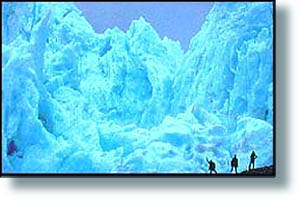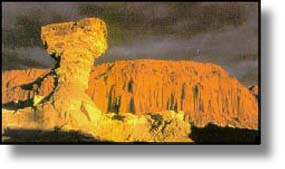Adventure in Argentina | Introduction to Buenos Aires | Exploring Buenos Aires | Latin America Homepage | The World
 Location, Geography Climate:
Location, Geography Climate:
Comprising almost the entire southern half of South America, Argentina is the world's eighth largest country, covering an area of 2.8 million square km. Argentina possesses some of the world's tallest mountains, expansive deserts, and impressive waterfalls, with the diversity of the land ranging from wild, remote areas in southern Patagonia to the bustling metropolis of Buenos Aires in the north.
Cuyo & the Andean Northwest
This area surrounding the Andes began as a colony of Peru, but today only a few miners and herders occupy this unforgiving region of volcanic peaks and salt lakes. Very little rain falls in Cuyo, though to the east are found the fertile river valleys and subtropical lowlands of the Gran Chaco.
Mesopotamia & the Northeast
Mesopotamia, a broad, flat plain between the Parana and Uraguay Rivers in northern Argentina, is wet, swampy and extremely hot during the summer. The northern province of Misiones, a more mountainous region nearly enclosed by Brazil and Paraguay, is densely forested and contains a section of the majestic Iguazu Falls.
The Chaco
This parched area in the west is part of the enormous Gran Chaco, a region that Argentina shares with Bolivia, Paraguay, and Brazil. The Chaco contains both grassland and thorny forest.
The Pampas
These fertile plains are Argentina's breadbasket. They consist of the Humid Pampas along the seaboard and the Dry Pampas in the west and south. The region includes Buenos Aires, as well as the world-class beaches of its surrounding area.
Patagonia and the Lake District
Much of Patagonia, and almost all of the area south of the Rio Colorado, experiences a desert climate, although temperatures range from mild to subzero and terrain varies from bucolic river valleys to the gigantic, ice-capped southern Andes. Its cool grazing grounds support enormous flocks of sheep, and numerous fruit and vegetable farms can be found in the valleys. Patagonia also holds vast reserves of oil and coal.
Tierra del Fuego
The Land of Fire is actually an archipelago including the Isla Grande de Tierra del Fuego (which Argentina shares with neighbouring Chile) and numerous smaller islands. Northern Isla Grande is similar in terrain to Patagonia's plains, while the mountainous area in the south is filled with forests and glaciers. Its climate is usually mild year-round, although storms are frequent.
It was perhaps a legacy of this successful resistance that enabled the native peoples of Argentina to carry on a prolonged campaign against colonization and rule by the Spanish. The first Spaniard to land in Argentina, Juan de Solis, was killed in 1516, and several attempts to found Buenos Aires were stymied by the local inhabitants. Inland cities were more successful, and it wasn't until the late 16th century that Buenos Aires was securely established.
Despite its military success, indigenous resistance was inexorably weakened by the introduction of diseases from Europe. Even after the native threat became minimal, however, Argentina was still mostly neglected by Spain, which was more interested in developing Lima and the riches of Peru. Buenos Aires was forbidden to trade with foreign countries, and the city became a smuggler's haunt. The restrictive trade policy probably did little to endear Spain to the colonists.
The British attacked Buenos Aires in 1806 and 1807, as Spain's had come under the control of Napoleonic France. The colony managed to repulse Britain's attacks without any assistance from their mother country, an act of strength that no doubt helped to foster the region's growing sense of independence. When the French captured Spain's King Ferdinand VII, Argentina fell completely under the rule of the local viceroyalty, which was highly unpopular. The locals rebelled against the viceroyalty and declared their allegiance to the captive king. By 1816, the deep division between Argentina and its mother country had become quite apparent, and a party of separatists decided to declare the country's independence. One of the new patriots, Jose de San Martin, crossed the Andes and captured Lima. Along with Simon Bolivar, Martin is credited with breaking the shackle of Spanish rule in South America.
Early independence in Argentina was marked by an often bitter struggle between two political groups: the Unitarists and the Federalists. The Unitarists wanted a strong central government, while the Federalists wanted local control.
Argentina's culture has been greatly affected by its immigrant population, mostly European. Their influence contributed to the demise of pre-Columbian cultures, resulting in the lack of a dominant indigenous population. The European immigrant groups each adopted different roles. The Basque and Irish controlled sheep rearing, the Germans and Italians established farms, and the British invested in developing the
country's infrastructure.
More than one-third of the country's 32 million people live in Buenos Aires, the capital, which along with other urban areas accounts for almost 90% of the total population. The principal indigenous peoples are the Quechua of the northwest and the Mapuche in Patagonia. Other marginal groups include the Matacos and Tobas in the Chaco and other northeastern cities. There are strong Jewish and Anglo-Argentine communities throughout the country; small communities of Japanese, Chileans and Bolivians; and enclaves of Paraguayan and Uraguayan residents.
The universal language of Argentina is Spanish, but many natives and immigrants keep their mother tongues as a matter of pride.
Its six major regions are as follows:
History & Culture Along with numerous nomadic tribespeople, two main indigenous groups existed in Argentina before the European arrival. In the northwest, near Bolivia and the Andes, was a people known as the Diaguita, while further south and to the east were the Guarani. Together the Diaguita and the Guarani constitute the origins of permanent agricultural civilization in Argentina, both developing the cultivation of maize. The Diaguita are also remembered for having successfuly prevented the powerful Inca from expanding their empire into Argentina from what is now Bolivia.
Along with numerous nomadic tribespeople, two main indigenous groups existed in Argentina before the European arrival. In the northwest, near Bolivia and the Andes, was a people known as the Diaguita, while further south and to the east were the Guarani. Together the Diaguita and the Guarani constitute the origins of permanent agricultural civilization in Argentina, both developing the cultivation of maize. The Diaguita are also remembered for having successfuly prevented the powerful Inca from expanding their empire into Argentina from what is now Bolivia.